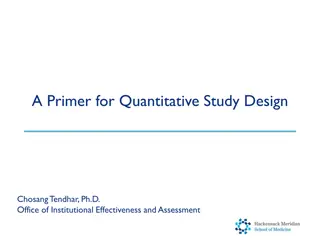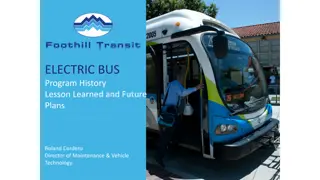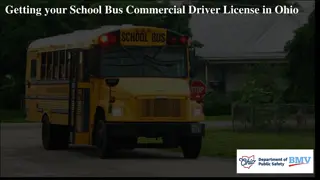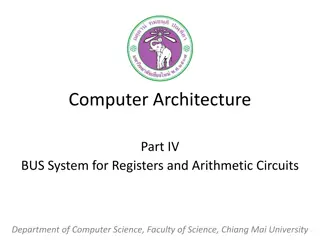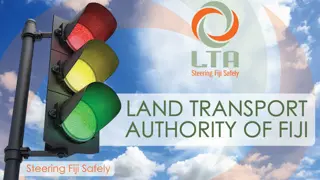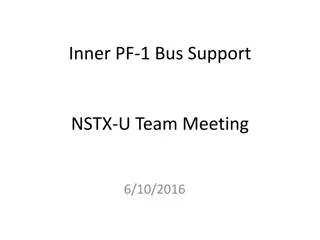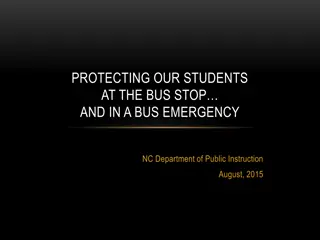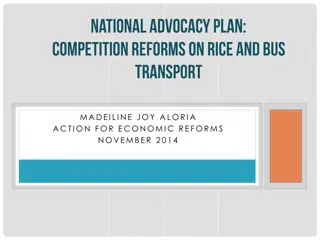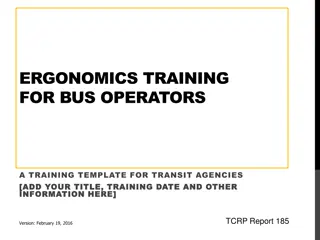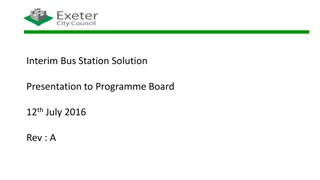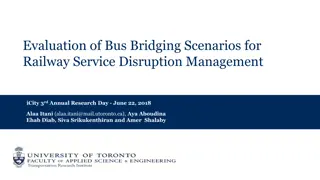Hours of Service Primer & Bus Standards Compliance
The federal regulations governing driving hours for passenger-carrying vehicles and compliance standards for school districts and contractors.
Download Presentation

Please find below an Image/Link to download the presentation.
The content on the website is provided AS IS for your information and personal use only. It may not be sold, licensed, or shared on other websites without obtaining consent from the author.If you encounter any issues during the download, it is possible that the publisher has removed the file from their server.
You are allowed to download the files provided on this website for personal or commercial use, subject to the condition that they are used lawfully. All files are the property of their respective owners.
The content on the website is provided AS IS for your information and personal use only. It may not be sold, licensed, or shared on other websites without obtaining consent from the author.
E N D
Presentation Transcript
Hours of Service Primer Montana Conference of Education Leadership Billings October 20, 2017 Lora Tauck, Business Manager/Clerk Ekalaka Public Schools Denise Williams, Executive Director MASBO
Federal Motor Carrier Safety Regulation 49 CFR 395.5 395.5 Maximum driving time for passenger-carrying vehicles. Subject to the exceptions and exemptions in 395.1: (a) No motor carrier shall permit or require any driver used by it to drive a passenger-carrying commercial motor vehicle, nor shall any such driver drive a passenger-carrying commercial motor vehicle: (1) More than 10 hours following 8 consecutive hours off duty; or (2) For any period after having been on duty 15 hours following 8 consecutive hours off duty. (b) No motor carrier shall permit or require a driver of a passenger-carrying commercial motor vehicle to drive, nor shall any driver drive a passenger-carrying commercial motor vehicle, regardless of the number of motor carriers using the driver's services, for any period after (1) Having been on duty 60 hours in any 7 consecutive days if the employing motor carrier does not operate commercial motor vehicles every day of the week; or (2) Having been on duty 70 hours in any period of 8 consecutive days if the employing motor carrier operates commercial motor vehicles every day of the week.
Excerpts From 2017 Bus Standards: Page 51: vii. Driving hours shall be regulated, and documented. All School districts and contractors shall not be exempt from regulations based on the Federal Motor Carrier Safety Regulation 49 CFR 395.3 (15 hours on duty of which no more than 10 hours are driving time; 8 hours continuous off-duty prior to a long trip; no more than 60 hours driving in a week). (This information will be audited.) Page 58: Driving hours shall be regulated, and documented. All School districts agencies shall not be exempt from regulations based on the Federal Motor Carrier Safety Regulation 49 CFR 395.5 (15 hours on duty of which no more than 10 hours are driving time; 8 hours continuous off-duty prior to a long trip; no more than 60 hours driving in a week). Page 68: Hours of service: The consecutive or cumulative period that a commercial driver may be on duty. Page 132 concerning activity trips: Hours of service Driver shall comply with the provisions of CFR 49, Part 395.5. Bus standards link: http://drive.google.com/open?id=0B6M9_9igOWskbHM3V1ZqRlNkQkU
From https://www.ecfr.gov/cgi-bin/retrieveECFR?gp=1&ty=HTML&h=L&mc=true&=PART&n=pt49.5.395#se49.5.395_12 Part 8 is the issue here: Definitions for On-duty Time: On-duty time means all time from the time a driver begins to work or is required to be in readiness to work until the time the driver is relieved from work and all responsibility for performing work. On-duty time shall include: (1) All time at a plant, terminal, facility, or other property of a motor carrier or shipper, or on any public property, waiting to be dispatched, unless the driver has been relieved from duty by the motor carrier; (2) All time inspecting, servicing, or conditioning any commercial motor vehicle at any time; (3) All driving time as defined in the term driving time; (4) All time in or on a commercial motor vehicle, other than: (i) Time spent resting in or on a parked vehicle, except as otherwise provided in 397.5 of this subchapter; (ii) Time spent resting in a sleeper berth; or (iii) Up to 2 hours riding in the passenger seat of a property-carrying vehicle moving on the highway immediately before or after a period of at least 8 consecutive hours in the sleeper berth; (5) All time loading or unloading a commercial motor vehicle, supervising, or assisting in the loading or unloading, attending a commercial motor vehicle being loaded or unloaded, remaining in readiness to operate the commercial motor vehicle, or in giving or receiving receipts for shipments loaded or unloaded; (6) All time repairing, obtaining assistance, or remaining in attendance upon a disabled commercial motor vehicle; (7) All time spent providing a breath sample or urine specimen, including travel time to and from the collection site, to comply with the random, reasonable suspicion, post-crash, or follow-up testing required by part 382 of this subchapter when directed by a motor carrier; (8) Performing any other work in the capacity, employ, or service of, a motor carrier; and (9) Performing any compensated work for a person who is not a motor carrier.
Log Books: A driver is exempt from the logbook or record of duty status requirements if he/she operates within a 100 air-mile radius of the normal work reporting location and is released from duty within 12 consecutive hours or less. Has at least 8 consecutive hours off duty separating each 12 hours on duty. And does not exceed 10 hours maximum driving time following 8 consecutive hours off duty
60/7 rule: A driver may not drive after more than 60 hours on duty in 7 consecutive days. Under 49 CFR 395.8(a), drivers must record their duty status for each 24 hour period, including all on-duty time. The definition of "on-duty time" in 395.2 includes "performing any compensated work for a person who is not a motor carrier." Therefore, all compensated work, whether for a motor carrier or not, must be included on the log as on- duty time and counted against the driver's available hours.
Multiple Employer Driver 395.8(j) Some passenger carriers make frequent use of part-time and multiple-employer drivers. When using a driver intermittently, obtain a signed statement from the driver that indicates the total time on duty during the preceding 7 days and the time at which the driver was last relieved from duty prior to using such driver. All compensated work for a motor carrier or a non-motor carrier is on-duty time.
15 Hour limit May not drive after having been on duty for 15 hours, following 8 consecutive hours off duty. Off-duty time is not included in the 15-hour period.
10-Hour Driving Limit 10-Hour Driving Limit May drive a maximum of 10 hours after 8 consecutive hours off duty.
Off Duty The driver must be relieved of all duty and responsibility for the care and custody of the vehicle, its accessories, and any cargo or passengers it may be carrying. During the stop, and for the duration of the stop, the driver must be at liberty to pursue activities of his/her own choosing and to leave the premises where the vehicle is situated.
Exception 395.1 (b) Due to adverse conditions, a driver is permitted to utilize 2 additional hours beyond the 10 hours drive time permitted to complete the run. This is for conditions that would be unknown prior to the beginning of the trip. For example, rush hour traffic does not count as an adverse condition
What are the penalties for violating the hours-of-service rules? Drivers or carriers who violate the hours-of-service rules face serious penalties: Drivers may be placed out of service (shut down) at roadside until the driver has accumulated enough off-duty time to be back in compliance; State and local enforcement officials may assess fines; The driver's and carrier's scores under the Compliance, Safety, Accountability (CSA) enforcement program can take a hit, which could result in a variety of enforcement actions; The Federal Motor Carrier Safety Administration may levy civil penalties on the driver or carrier, ranging from $1,000 to $11,000 per violation depending on the severity; The carrier's safety rating can be downgraded for a pattern of violations; and Federal criminal penalties can be brought against carriers who knowingly and willfully allow or require hours-of- service violations.
Upcoming Issues: Entry Level Driver Training Rules: Require each driver to attend a certified training school during the CDL application process. This goes into effect Feb. 7, 2020. Per the final rule, applicants seeking a CDL will have to demonstrate proficiency in knowledge training and behind-the-wheel training on a driving range and on a public road. Also, training providers must determine that each CDL applicant demonstrates proficiency in all required elements of the training to successfully complete the program.




